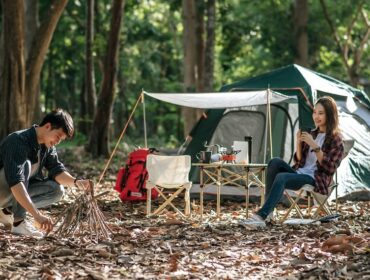Fires provide heat and a way to cook when you’re out in the wild. Sometimes they are necessary for survival. Other times, they create a lovely ambiance with family and friends. Either way, you’ll want to understand how to safely start, light, and maintain a fire. Fire stewardship and safety is an important aspect of getting outside.
There are several different types of campfires that are suitable for different conditions and needs. Knowing what type of fire to use means you’ll have a more efficient burn. Let’s dive into how to start a fire and the different ways to maintain, build, and keep your fire safe.

Where to Start a Fire
One of the most important things about starting a fire is knowing a safe place to start one. It doesn’t matter where you are, fires leave a scar on the environment. So the best place to start a fire is where there has been a fire previously.
If you’re at a campground, you’ll want to use the provided fire rings (if fires are allowed). Keep in mind many campgrounds no longer allow fires, especially many backcountry sites in National Parks.
When you’re dispersed camping or backpacking, only camp at previously designated spots. Use the fire rings that are already built. Typically these will be stacked rock rings. By keeping the fire where it was previously, you’re limiting scars on the environment.
If there is no previous fire pit, you should continue to look for one or find another place to lay a fire. However, emergencies do happen. If this is the case, choose a hard surface, like a rock or patch of dirt. Build a fire ring far from trees or any deadfall that may light up from a rogue spark. Use rocks to build up a ring to keep the fire as contained as possible.

Choose the Best Fire Lay
There are several different ways to build a fire. Different shapes — or lays — of fire are suited for different conditions and activities. Choose the one that best suits your needs.
Regardless of the lay, all fires need kindling to light. Kindling refers to small pieces of insatiable material. A few types of kindling — also referred to as tinder — include:
- Small pieces of bark
- Small pieces of wood, no thicker than a pencil
- Dried leaves
- Dryer lint dipped in candle wax
Start with a pile of kindling then use one of the many types of fire lay. Lay and build your wood above the kindling. You want to start with thinner pieces of wood first, then build up to thicker logs as the fire builds. Leave ample room between pieces of wood, since fire is fueled by oxygen. The fire won’t stay lit if it’s too smothered and choked.
Now that you have your wood piled up, it’s time to build. Here are the different types of fire lays and when to use each one.

Tipi Fire
This is the most basic and versatile fire lay. Start by leaning small sticks together over your kindling like a cone-shaped tipi. Once you have a medium-sized tipi (think logs no thicker than two inches) light the kindling and blow into the center of the tipi until some of the bigger sticks began to catch. This type of fire is perfect if you need a fire quickly and you want even heat.

Log Cabin Fire
The log cabin fire is exactly what it sounds like, a log cabin-like structure. Perfect for cooking, this is the ideal fire structure for a longer burn. Start by layering sticks around kindling in a box shape. Slowly build until the structure uses 2-inch thick sticks. Then light the kindling while blowing on it to foster bigger flames.

Lean-to-Fire
If there’s a lot of wind or damp wood, then the lean-to-fire is perfect. Place kindling on the edge of the fire ring, then layer on sticks, getting increasingly larger, by leaning them against the fire ring. Once it’s been built up a little bit, light the fire. Just be sure that the sticks are shorter than the fire ring walls (build up the walls if you have to) so the fire doesn’t spread outside the ring.

Log Fire
A simple fire that doesn’t collapse is a log fire. This uses parallel logs to ignite a flame. Simply place your kindling in the center of the ring, then place two smaller logs next to the pile. This quick fire is great in a pinch and doesn’t require that much fuel.
Fueling the Fire
Now that your fire is lit, you’ve got to feed it fuel. The best way to do this is to slowly add larger and larger logs. You don’t want to overwhelm the fire with wood, so adding one to two logs at a time ensures that the fire will continue to grow.
As coals burndown, you’ll want to poke and stoke them to encourage heat release. This will help ignite new logs and keep the fire hot. If the logs are damp or wet, you can put them near the fire to dry out. Then, using a fire stick, you can push them onto the fire.
Keep in mind the structure of the fire will collapse over time but, if you keep the general shape of your chosen fire lay, logs will continue to ignite on their own.
Putting Out the Fire
Forest fires are started every year by poor fire management. One of the biggest culprits is not properly putting a fire out. The absolute best way to put out a fire is with water — and lots of it.
Start by pouring water over the fire. You’ll want to put plenty of water over the fire, where it’s completely soaked. Next, you’ll need to stir the ash pit and turn over logs. You can use a poker or a fire stick to stir the ashes and bump logs. Now you’ll put more water on the fire. Repeat this process until the fire stops sizzling and there are no red hot embers when you stir the fire.
After this, you should bury the fire with dirt. This ensures that if you missed a lump of hot coal, it doesn’t spark and re-ignite the fire.
If you don’t have enough water, fully bury the fire. Just remember, by burying the fire, the coals still remain super hot. It will take a long time — sometimes days — for the fire to truly go out underground. So do not step or walk on the dirt.
If you can’t bury the fire because of rocks, hard dirt, or other reasons, be sure to use more water and completely drown the fire. You’ll want the fire pit to look like a soup pot.

Safety Tips
Fire safety is important for obvious reasons, but staying safe with fire isn’t always intuitive. There are a few things to keep in mind, especially when outside, if you’re managing a fire. Here are a few tips to help you out.
- Always fully put out a fire before heading to bed or leaving a campsite. Forest fires are started every year by campers leaving a fire unattended.
- Never leave a fire unattended. Always make sure you have water nearby in case things get out of control.
- Wet or damp wood tends to pop, sending embers flying. When you first light your fire or add a damp piece of wood, stand back and wait until the wood has dried in the fire. Also, be sure to keep a close eye on pets and kids.
- Use a fire stick to manage and maintain the fire. You can use a stick you find or you can use metal fire tools with protective handles.
- Keep a shovel nearby, such as an e-tool, to bury the fire.
- Never put trash in a fire. It’s smoky and can attract unwanted wildlife visitors.
- Always look up local fire regulations before heading out. During dry seasons, many jurisdictions limit or prohibit fires.
When you’re armed with the knowledge of safe and efficient fire building, you can stay warm or cook a delicious meal while you’re outdoors. Understanding how to build a fire and what type of fire to build delivers you more comfortable outside. As an expert in fire safety, you can ensure that you’re recreating responsibly and having fun while doing it.
Article and Photos by Meg Atteberry
Meg Atteberry wants to empower you to have the ultimate outdoor adventure. She loves to use her writing work to help people level up their outdoor skills. You can find her climbing, camping, and hiking across her home in Colorado and the American Southwest. When she’s not out exploring, she’s at home cooking up delicious meals from around the globe and curling up with a good Sci-Fi book. You can follow Meg’s adventures at Fox in the Forest.




